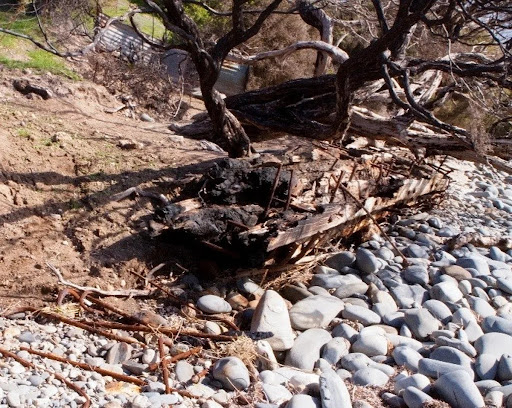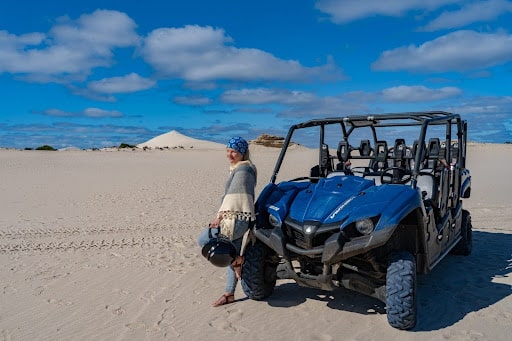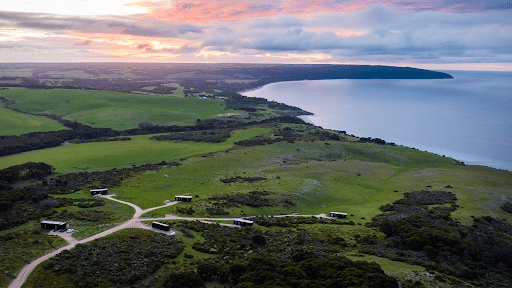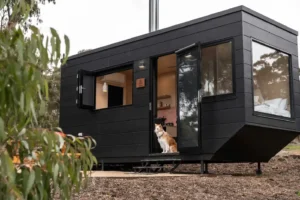If you’re planning an eco-escape anywhere in South Australia, there’s one destination that stands out on the map: Kangaroo Island. Tucked off the South Australian coast with over 4,000 square kilometres of unspoiled wilderness, white-sand beaches, ancient geological formations, and a fiercely protected ecosystem, this island invites you to disconnect from the daily grind and reconnect with nature.
Whether you’re camping beneath the stars or staying in a secluded off-grid cabin like those offered by CABN, you’ll find there’s far more than meets the eye. This wild, windswept sanctuary offers more than just postcard views. It’s an island where sea lions laze on the sand, Ligurian honey bees work away in solitude, and ancient rock formations watch over rolling bushland.
But how much do you really know about Kangaroo Island? Let’s explore 10 facts about Kangaroo Island that reveal its curious past, rare wildlife, and hidden corners you might miss.
Top 10 Facts About Kangaroo Island You Should Know
1. Kangaroo Island is Australia’s third-largest island
Spanning a total area of 4,400 square kilometres according to the Kangaroo Island Council, Kangaroo Island is bigger than Bali. It sits just 13 kilometres off the coast of mainland Australia, south-west of Adelaide.
The island stretches 145 kilometres at its longest point, while its width narrows to just 0.9 kilometres at some points. Driving from one end to the other takes about two hours, but you’ll want to take your time. Every bend reveals something new: coastal cliffs, hidden beaches, or roos crossing the road.
Over 4,600 people call the island home, but the real locals include kangaroos, echidnas, sea lions, and koalas. It’s wild in the best way.
2. The island is home to the world’s only pure Ligurian bee sanctuary
One of the most surprising facts about Kangaroo Island is its relationship with bees. In 1884, Ligurian honey bees were imported from Italy to Kangaroo Island, and they’ve been thriving ever since. A year later, the island was declared a bee sanctuary.
Due to strict biosecurity laws, no new bees, honey, or hive products can be brought onto the island.
Why is that a big deal? Because KI is now the last place on Earth with genetically pure Ligurian bees, free from pests and diseases that affect hives worldwide. Beekeeping here isn’t just a hobby but a heritage. Their honey is highly prized for its unique taste and medicinal properties.
3. Flinders Chase National Park is a natural marvel born from fire and resilience
You can’t talk about Kangaroo Island facts without mentioning Flinders Chase National Park.
Located on the island’s rugged south coast, this park is where nature shows off. You’ve got the windswept coastal cliffs, Remarkable Rocks (a surreal set of granite boulders shaped by 500 million years of erosion), and the boardwalk down to Admirals Arch, where New Zealand fur seals laze around like they own the place.
Around 96% of Flinders Chase National Park was destroyed during the 2019–2020 bushfires, but nature knows how to bounce back. Today, this iconic park is alive again: gum trees sprout from scorched trunks, wildlife returns, and the coastline is as dramatic as ever.
The park covers over 326 square kilometres and is one of Australia’s oldest conservation areas. The drive along the island’s rugged south coast is breathtaking, especially at sunset.
4. Cape Willoughby has South Australia’s first lighthouse
Perched on the Dudley Peninsula, Cape Willoughby Lighthouse was built in 1852. It was the first to be erected in South Australia, warning ships off the island’s rocky coastline. Today, you can tour the lighthouse, stay overnight in the lightkeeper’s cottage, or just enjoy the view. It’s also a great spot for whale watching in winter.
If you’re looking for a more remote eco-stay nearby, CABN’s off-grid cabins offer a chance to disconnect and soak up this maritime history with nature as your soundtrack. Cape Willoughby is just 8 8-minute drive from any of the four CABN X at St. Cape Alban.
5. There are over 80 shipwrecks just off the coast
With a coastline that spans 540 kilometres, Kangaroo Island’s waters have seen their fair share of tragedy. Since the early days of European exploration, over 80 shipwrecks have occurred around the island, many still lying submerged today.
If you’re a diving enthusiast or a maritime history buff, sites near Cape St Albans Lighthouse and Cape Willoughby offer haunting yet beautiful underwater shipwreck explorations.
One of the famous and most explored shipwrecks by the coast of Kangaroo Island is the Kona, located at Antechamber Bay (precisely at -35.807023 °S 138.140248 °E)

6. American River is a sleepy fishing village with a curious name
Despite the name, the American River isn’t a river, nor is it particularly American. It was named after a group of American sealers who camped here in 1803 while building a schooner. Today, it’s a quiet haven known for oyster farming, pelicans, and stunning sunrises.
CABN Kangaroo Island guests often kayak through the calm inlet waters or hike the nearby trails. It’s one of those places that rewards early risers and slow travellers.
7. The island has its own mini desert: Little Sahara

Right in the middle of the island lies Little Sahara, a naturally occurring series of sand dunes spread over 2 square kilometres. It’s one of the best Kangaroo Island activities for adventure lovers. You can sandboard, toboggan, or simply admire the windswept views.
It’s also a great example of how Kangaroo Island’s coastline and inland terrains offer completely different landscapes within a short drive.
8. KI is one of the best places to see the elusive Kangaroo Island dunnart
This tiny, mouse-sized marsupial is found only on the island and nowhere else in the world. It’s critically endangered, and recent bushfires put it at serious risk. The species is slowly recovering thanks to conservation programs, including habitat protection within Flinders Chase.
You might spot one on a twilight walk if you’re lucky and quiet. But be warned: they’re fast, shy, and nocturnal.
9. Kangaroo Island is home to South Australia’s only gin distillery
Sited in Cygnet River, Kangaroo Island Spirits (KIS) is South Australia’s only distillery and a trailblazer in small-batch craft gin. They use native botanicals like coastal daisy and boobialla (native juniper) to create award-winning blends.
Visitors can book a tasting, try their hand at gin-making, or pick up a bottle to enjoy back at your cabin under the stars. It’s just another way to connect with the island’s flavours and stories.
10. The southern rock lobster here is some of the best in the world
The southern rock lobster is one of the tastiest and most valuable seafood exports from the island. Harvested sustainably by local fishers, it’s prized for its sweet, delicate flavour and firm texture.
During the season, you’ll find it on menus across the island, especially at fine-dining venues in Kingscote or Penneshaw. Pair it with a local white wine or sparkling from Dudley Wines for a special treat. This is one of many wineries scattered across the island’s rolling hills.
Frequently Asked Questions
How old is Kangaroo Island?
Kangaroo Island separated from mainland Australia roughly 10,000 years ago due to rising sea levels at the end of the last Ice Age. Archaeological finds show Indigenous presence on the island dating back at least 16,000 years, though it was uninhabited at the time of European discovery.
Why is Kangaroo Island so famous?
It’s famous for its unspoilt landscapes, wildlife, and eco-tourism experiences. With over one-third of the island protected as national park or conservation land, it’s a top destination for nature lovers, especially those seeking off-grid stays like those offered by CABN.
Where is the best place to stay on Kangaroo Island?
If you want peace, privacy, and a true eco-conscious experience, stay at CABN’s off-grid cabins nestled near Flinders Chase National Park, American River, or Cape Willoughby. You’ll be surrounded by nature but still connected to the island’s spirit.
What is the best time to visit Kangaroo Island?
The island has a mild climate all year, but March to May and September to November are ideal for avoiding crowds and spotting wildlife.
How do you get to Kangaroo Island?
You can reach Kangaroo Island via Kangaroo Island Connect ferry from Cape Jervis or by flying directly from Adelaide to Kingscote. Either way, it’s part of the adventure.
Ready to Discover Kangaroo Island with CABN?
There are few places in Australia as untouched, mysterious, and quietly powerful as Kangaroo Island. While most travellers come for the coastlines and native animals, what they often leave with is a sense of being somewhere truly different. If you’re considering an off-grid escape with CABN, these stories and facts make this island more than a postcard.
Whether you’re after fun facts about Kangaroo Island, rare wildlife sightings, or a spot just to unwind, this island delivers. CABN offers the perfect eco base to explore its secrets: slow mornings, birdsong, ocean views, and a fire under the stars.
Book your off-grid stay ahead at CABN Kangaroo Island today and see how much more there is to love when you live simply.



